
Sixty years ago today, the United States dropped an atomic bomb on Nagasaki. We hear from a survivor of the bombing and the men who flew the B-29 bomber that dropped the bomb. [includes rush transcript]
A ceremony in Nagasaki today marked the 60th anniversary of the U.S. bombing of that city. The plutonium atomic bomb caused the death of more than 80,000 people in Nagasaki, coming just three days after an equally deadly uranium bomb devastated Hiroshima.
Japanese Prime Minister Junichiro Koizumi addressed approximately six thousand people attending the ceremony. He said, “With the firm decision not to ever let the tragedies of Nagasaki and Hiroshima be repeated, we will adhere to a pacifist constitution and uphold the three rules for non-nuclearization. We will also take the lead in non-proliferation in the world and make effort in the abandoning of nuclear weapons.”
Nagasaki Mayor Iccho Itoh said at the ceremony, “The United States has 10,000 nuclear weapons, has conducted sub-critical nuclear tests and on top of that is pursuing the development of miniature nuclear weapons. Do the American people really think the policies of their country are going to bring about peace? We know that most of you are actually really seeking the abolition of nuclear weapons. We should all unite to bring peace to the world.” Mayor Itoh also addressed citizens of the United States. He said “We understand your anger and anxiety over the memories of the horror of the 9/11 terrorist attacks. Yet, is your security enhanced by your government’s policies of maintaining 10,000 nuclear weapons?”
- Excerpt from the documentary “Hiroshima Countdown” produced by Andrew Phillips
- Sakue Shimohira, a survivor of the U.S. atomic bombing of Nagasaki
- Related link: Read ” Atomic truths plague prize coverup” by Juan Gonzalez in today’s New York Daily News
Transcript
AMY GOODMAN: The Japanese Prime Minister, Koizumi, spoke out against nuclear proliferation at the ceremony.
PRIME MINISTER JUNICHIRO KOIZUMI: With the firm decision not to ever let the tragedies of Nagasaki and Hiroshima be repeated, we will adhere to a pacifist constitution and uphold the three rules for non-nuclearization. We will also take the lead in nonproliferation in the world and make effort in the abandoning of nuclear weapons.
AMY GOODMAN: Also at today’s ceremony, Nagasaki Mayor Ichho Itoh addressed the 6,000 people assembled to remember the atomic bombing.
MAYOR ICCHO ITOH: The United States has 10,000 nuclear weapons, has conducted sub-critical nuclear tests and on top of that is pursuing the development of miniature nuclear weapons. Do the American people really think that the policies of their country are going to bring about peace? We know that most of you are actually really seeking of the abolition of nuclear weapons. We should all unite to bring peace to the world.
AMY GOODMAN: Mayor Itoh addressed citizens of the United States. He said, quote, “We understand your anger and anxiety over the memories of the horror of the 9/11 terrorist attacks. Yet, is your security enhanced by your government’s policies of maintaining 10,000 nuclear weapons?” We turn now to an account of the 1945 atomic bombing of Nagasaki by the pilots who flew the B-29 bomber that dropped that bomb. This is Frederick Ashworth from the documentary Hiroshima Countdown, produced by Andrew Phillips.
FREDERICK ASHWORTH: There was a tremendous suspense and tension as we approached the target, because we had just failed to be able to bomb our primary target. We made our test as we proceeded into the dropping point. I knew that everything was functioning perfectly. At that time the bombardier took over. He did an excellent job. As soon as the bomb was released, there was considerable relief. And I knew when I saw the flash of the explosion, that the second atomic bomb had been successfully delivered to the enemy.
REPORTER: This is Major Charles W. Sweeney of Quincy, Massachusetts, proud of “The Great Artiste,” the second B-29 to drop an atomic bomb on the empire. Major Sweeney, give us some of the details of the whole flight.
CHARLES SWEENEY: We were briefed on, of course, a primary and a secondary target, as usual. We took off, and the flight was uneventful, except for some weather on the way up. The primary target was located, and we made three runs on it but were unable to get into it. Commander Ashworth and I held a little conference with the bombardier and the navigator, and we started for the secondary target, which was Nagasaki, at which time the flight engineer told us we had just 13,000 gallons of gasoline left. We picked our route into the secondary target and dropped it on Nagasaki. We were very relieved to have it go, much more relieved when we saw the tremendous flash and knew that it had functioned. At that point we hit the road for Okinawa, the first petrol station.
NARRATOR: Physicist Philip Morrison was on Tinian Island at that time.
REPORTER: Were you there when the bomber crews took off?
PHILIP MORRISON: The combat bomb crews?
REPORTER: Yeah, when Tibbets and Sweeney took off.
PHILIP MORRISON: Oh, yes, of course.
REPORTER: Could you —
PHILIP MORRISON: Yes, I was responsible for loading the Nagasaki bomb, putting it together on Tinian and getting it loaded onto the aircraft. My responsibility extended really only to the nuclear core, and then somebody else had the high explosives, somebody else had the firing set, somebody else had the loading job. But we were several groups from Los Alamos, went there especially to be in charge of these two bombs. Tibbets dropped the Hiroshima bomb. That was my baby, but I was just a bystander. But the Nagasaki bomb, I was directly involved.
REPORTER: This is one of a series of interviews conducted by the Air Force historical division. Today, we are interviewing Brigadier General Paul W. Tibbets, Jr.
PAUL TIBBETS, JR.: They were definitely military targets. There was no question about that. And they offered such a — well, you could almost say a classroom experiment, as far as being able to determine later the bomb damage. These were good virgin targets, and they were ideal for the purpose that we wanted to use them for.
PAUL TIBBETS, JR.: The consideration of targets would be Hiroshima, Nagasaki, Niigata, Kokura, and there’s one more that I don’t remember. The 20th Air Force had been told they would not attack those targets under any circumstances. In other words, the ground was laid.
NARRATOR: As well as these targets, Kyoto, Japan’s ancient capital, was strongly recommended by the man with overall control of the bomb project, General Leslie Groves. But Secretary of War Henry Stimson, approaching 80 years of age, would not have it. He had visited Kyoto with his wife in the '20s and had enjoyed the city's cultural riches. It was a city of great religious significance to the Japanese, and Stimson felt Kyoto’s destruction would damage America’s post-war stature.
UNIDENTIFIED: The selection of the targets in the month of May 1945 was actually done by the intelligence community in headquarters, U.S. Air Force. The requirements given to them was: You will select cities that have military targets in them. And they also selected the type of terrain that they wanted. They also were interested in the type of construction that they could expect to run into, because in reality not only was this a military mission, but it was also of extreme scientific importance, because they wanted to know what a weapon of this type could do against reinforced concrete, what it could do against steel, what it would do against anything that was in the building materials line. It had to be something that had not been attacked by the 20th Air Force up to that time, call it virgin targets, undamaged, unhurt by any other type of an explosive or munition.
CHARLES SWEENEY: I know the type of bomb we were working on…
NARRATOR: Charles Sweeney flew with Tibbets in an observer aircraft to witness the bombing of Hiroshima. Three days later he lead his crew first to Kokura, the primary target for the second bomb, and then to Nagasaki. Kokura was clouded in that day.
CHARLES SWEENEY: As he was talking he picked up a handful of earth. He said, “Basically what we’re working on is a single bomb that will turn a whole city into this.” And he just tossed a handful of sand into air.
AMY GOODMAN: The voices of the men who loaded and flew the B-29 bomber that dropped the atomic bomb on Nagasaki, August 9, 1945, from the documentary Hiroshima Countdown, produced by Andrew Phillips. You can go to our website later today, and we’ll have the full hour documentary. We turn now to a survivor of the atomic bombing of Nagasaki at 11:02 a.m., August 9. At the time of the explosion, Sakue Shimohira was in an air raid shelter one kilometer away from the epicenter. She was ten years old. She spoke at a rally in New York’s Central Park on May 1.
SAKUE SHIMOHIRA: [Translated from Japanese] Suddenly I felt a blinding flash. It was too enormous and intense to describe. Just a flash. Next, the blast blew us off. When I regained consciousness, I found my younger sister in the corner of the shelter and my nephew under the tatami mat. Auntie Matsuda, blackened all over her body, with her baby, also seared, in arms, arrived and collapsed. She had a big open wound on her throat. We gave her water. When she was drinking it, water was also streaming out of her open wound. She said, “It tasted so good. Thank you,” and died. My brother, too, vomiting yellow matter and crying, “I don’t want to die.” And he died. Both my mother and my elder sister were found dead and seared around our house.
My sister and my nephew and I survived in our family. We were taken separately to our relatives’ families. Later, my sister suffered appendicitis and had surgery, but the wound would not heal, perhaps because of the after-effects of radiation. Depressed so much by the wound, on a drizzly spring day, she jumped into the train and killed herself at the age of 19. Recently, one neighbor died after he had spent 38 years in hospital. When he passed away, his family said to him, “Father, now you can finally rest in peace.”
At the end of 30 years suffering, Hibakusha have to give such a sad word of farewell. To whom should they direct their disconsolation and indignation? Please understand that there are still many more Hibakusha who can find escape from their suffering in death only. No one in whichever country in the world should ever experience the same suffering that we have gone through. I firmly believe that Nagasaki should be made the last victim city of the atomic bombing. Desperately wishing for world peace, please, all together: No more Hiroshima! No more Nagasaki! No more Hibakusha! No more war!
AMY GOODMAN: Nagasaki bombing survivor, Sakue Shimohira, speaking in New York on May 1. I encourage people to read today’s column in the New York Daily News by my co-host, Juan Gonzalez, called ” Atomic Truths Plague Prize Coverup.” It focuses on the story we have been covering extensively around the anniversary of the atomic bombings of Hiroshima and Nagasaki, that’s the role of the Pulitzer Prize-winning The New York Times correspondent, William Laurence, as a paid government propagandist, selling the glories of the atomic bombings. He was both a New York Times reporter at the time of the bombings, as well as on the payroll of the U.S. War Department. This week I head up to the Pulitzer board at Columbia University to deliver a request that the Pulitzer strip the Times and William Laurence of that prize.

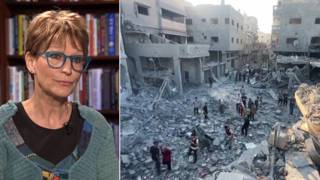
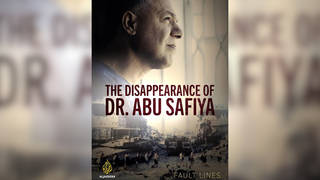
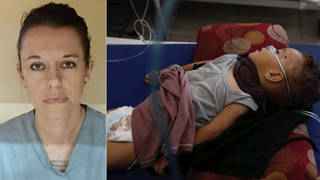
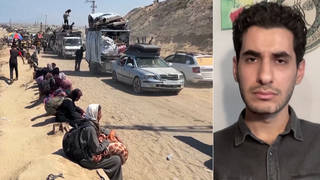
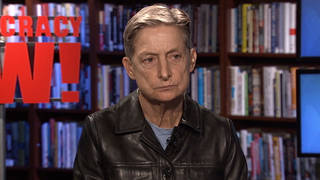
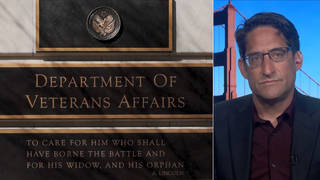
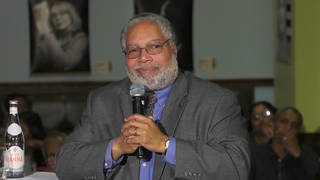
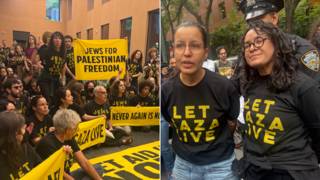

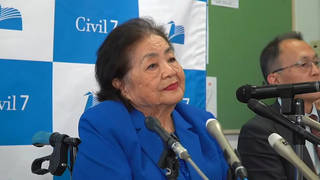
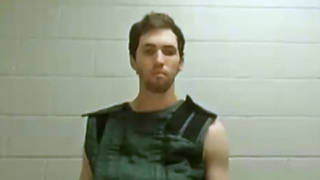
Media Options